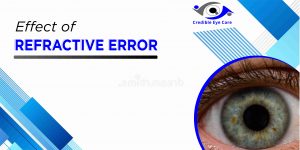
WHAT IS A REFRACTIVE ERROR?
Refractive error is a frequent eye disorder in which the shape of the eye prevents light from concentrating directly on the back of the eye, resulting in blurred vision and other symptoms.
It happens when the eye is unable to clearly focus on images from the outside world. Refractive errors induce blurred vision, which can be very severe and it can cause visual impairment.
Almost 150 million Americans have a refractive error, but many are unaware that they could see better. That is why regular eye exams are so vital.
What are the symptoms of refractive errors?
The most common symptom is blurry vision. Other symptoms include:
- Double vision
- Hazy vision
- Seeing a glare or halo around bright lights
- Squinting
- Headaches
- Eye strain (when your eyes feel tired or sore)
- Trouble focusing when reading or looking at a computer
- Crossing of the eyes in children (esotropia)
Some people may not notice signs of refractive defects. It’s critical to have frequent eye exams, so your eye doctor can ensure you’re seeing clearly.
If you use glasses or contact lenses and continue to have these symptoms, you may require a new prescription. If you are suffering from visual problems, consult your eye doctor and have an eye exam.
Am I at risk for refractive errors?
Anyone can have refractive problems, but if you have family members who wear glasses or contact lenses, you are at a higher risk.
The majority of refractive defects, including nearsightedness, begin in childhood. Presbyopia is frequent in persons over the age of 45.
Consult your doctor about your risk for refractive problems and how frequently you should be tested.
What causes refractive errors?
Refractive errors can be caused by:
The length of the eyeball (when the eyeball grows too long or too short)
Issues with the cornea’s shape (the clear outer layer of the eye)
deterioration of the lens (an inner part of the eye that is normally clear and helps the eye focus)
What’s the treatment for refractive errors?
Refractive errors can be corrected with glasses or contact lenses, or they can be corrected with surgery.
GLASSES – Correcting refractive errors with glasses is the easiest and most secure method. Your eye doctor will prescribe the best eyeglass lenses for you to have the clearest vision possible.
CONTACT – Contact lenses are worn on the surface of the eyes and are used to correct refractive problems. Your eye doctor will fit you for the appropriate lenses and demonstrate how to clean and wear them properly.
SURGERY – Certain surgeries, such as laser eye surgery, can modify the shape of your cornea to correct refractive problems. Your eye doctor can advise you on whether surgery is appropriate for you.

